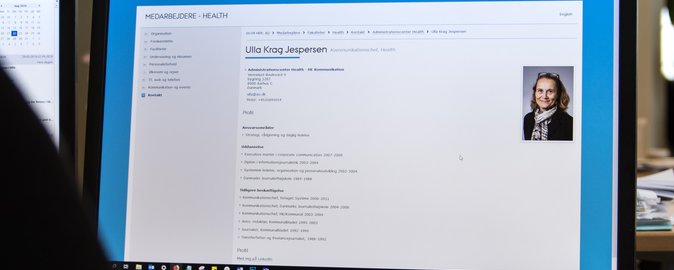- Education
-
Research
Current research
Talent
-
Collaboration
Businesses
Government agencies and institutions
Alumni
-
About AU
Organisation
Job at AU
You’ve probably heard it a hundred times: You must update your PURE profile. But PURE is not just about registering scientific articles. PURE is also the foundations preferred method of finding the right researchers for a project or an assessment committee.
2019.05.27 |

Foundations often use PURE as the initial point of contact when they need to find a researcher for a specific task. If the profile is not updated, it risks undermining your credibility. Photo: Health Communication.
It is not just about costing the university money if your PURE profile is not up-to date when registering scientific articles in the bibliometric research system (BFI). It is also about the risk of undermining credibility because foundations and other professionals often use PURE as the initial point of contact when they need to find a researcher for a specific task.
"You get the impression that the PURE profiles are out of date. I looked at a researcher’s profile and could see that he hadn't published anything since 2011, but of course I know that can’t be right. He hasn't just been sitting there doing nothing for years! It’s important that the pages are up-to-date with contact information, CV and publications."
This is an example of a comment by a director in one of Denmark's largest foundations that was made in an internal survey ordered by Health. The fact that PURE generally pops up as the first search result simply emphasises the importance of having an updated profile.
The survey also shows that foundations are network-based in their approach to research and that they often look for researchers with a specific academic profile. Anyone searching online for a researcher to e.g. a project or an assessment committee will generally find and click on a PURE profile first.
It is a well-known fact that PURE is used for registering research so that the university can receive money from the bibliometric research indicator – called BFI in Denmark. For this reason the list of publications is sometimes the only thing that is updated in PURE.
But Aarhus University also wants its researchers to be active, popular research communicators of their subjects. Journalists and academic and professional media use PURE to find out whether you are suitable as an expert, and here an updated list with communicative activities can benefit you and ensure that you are the person they contact because of the special knowledge you have about your field.
Your PURE profile can also determine whether you are nominated for an award or appointed to an academic committee under the university's auspices. This is because the information in PURE is often what the management has to go on when they want to nominate an employee for a special award or make an appointment to a council or committee.
Some AU employees have the impression that PURE profiles are irrelevant and that nobody ever looks at them. But this view is completely wrong. While there are no visitor statistics available for PURE, the fact that PURE appears as the first search result in Google strongly suggests that they are among the most visited webpages at Aarhus University.
The survey of the webpages which Health had carried out on 2018 shows that personal PURE profiles are among the most in demand according to foundations, companies and external partners. However, our PURE profiles do not always give the best impression of Health and the correlation between researchers and research groups.
If a PURE profile is not updated, it can ruin the overall impression of the external websites for visitors. The report shows that the user experience of the PURE profiles is that they are part of Health’s web universe, so that if that if a visitor meets a PURE profile that is not updated, this rubs off on their impression of the entire website.
PURE is an IT system which is used for registering and presenting research and research dissemination.
What is data from PURE used for?
Search results in e.g. Google and Bing
Calculating bibliometric research indicators
AU's key figures (extracted in March)
Information for the management